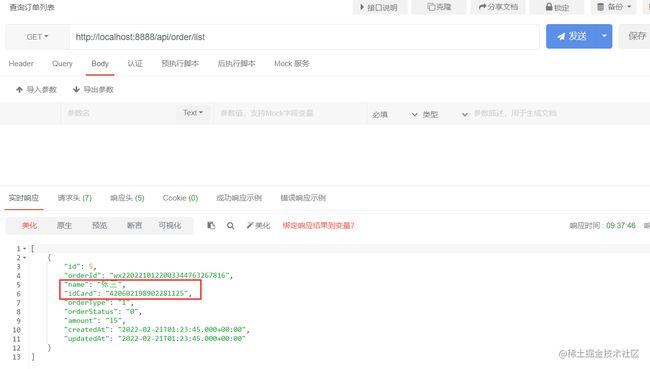前言
互联网行业公司,对于数据库的敏感字段是一定要进行加密的,方案有很多,最直接的比如写个加解密的工具类,然后在每个业务逻辑中手动处理,在稍微有点规模的项目中这种方式显然是不现实的,不仅工作量大而且后期很难维护。
目前mybatis-plus已经提供了非常好的加解密方案,居士也试过效果很好,但很多互联网公司不一定会引入mybatis-plus作为数据层工具,反而就喜欢使用mybatis,甚至有不少使用SpringDataJPA,那么就没有必要为了加解密专门引入mybatis-plus。
那有什么更合适的方案呢?答案是肯定的,shardingsphere就提供了方案,为什么选择它呢,因为互联网公司大概率会考虑分库分表,目前最佳的分库分表方案实际上也就是shardingsphere了,既然如此,直接用它的数据库加解密方案就不需要再额外引入第三方工具了。
使用
1、案例准备
技术体系如下,其中引入MybatisPlus是为了方便案例更快成型,ShardingSphere不建议使用5.x版本,因为版本差异较大一直都是大家对其诟病的原因,甚至小版本都有不少差异,4.x版本相较来说资料更多。
| 技术 | 版本 |
|---|---|
| SpringBoot | 2.6.3 |
| MybatisPlus | 3.5.1 |
| ShardingSphere | 4.1.1 |
2、引入依赖
org.springframework.boot
spring-boot-starter-web
org.apache.shardingsphere
sharding-jdbc-spring-boot-starter
4.1.1
mysql
mysql-connector-java
runtime
com.baomidou
mybatis-plus-boot-starter
3.5.1
com.baomidou
mybatis-plus-generator
3.5.1
org.freemarker
freemarker
2.3.31
io.springfox
springfox-swagger2
2.7.0
io.springfox
springfox-swagger-ui
2.7.0
org.springframework.boot
spring-boot-configuration-processor
true
org.projectlombok
lombok
true
com.alibaba
fastjson
1.2.79
org.springframework.boot
spring-boot-starter-test
test
3、yml配置
server:
port: 8888
# 数据源
spring:
# shardingsphere配置
shardingsphere:
props:
sql:
show: false
query:
with:
cipher:
column: true # 查询是否使用密文列
datasource:
name: master
master:
type: com.zaxxer.hikari.HikariDataSource
driver-class-name: com.mysql.cj.jdbc.Driver
jdbc-url: jdbc:mysql://localhost:3306/encrypt_demo?serverTimezone=GMT%2B8&useUnicode=true&characterEncoding=utf8&useSSL=false
username: root
password: 123456
initial-size: 20
max-active: 200
min-idle: 10
max-wait: 60000
pool-prepared-statements: true
max-pool-prepared-statement-per-connection-size: 20
time-between-eviction-runs-millis: 60000
min-evictable-idle-time-millis: 300000
validation-query: SELECT 1
test-while-idle: true
test-on-borrow: false
test-on-return: false
filter:
stat:
log-slow-sql: true
slow-sql-millis: 1000
merge-sql: true
wall:
config:
multi-statement-allow: true
# 加密配置
encrypt:
encryptors:
my_encryptor:
type: mySharding # 声明加密处理器的类型,自定义。
props:
aes.key.value: fly13579@# # 加密处理器创建密钥会用到,10个数字英文字母组合,自定义。
# 需要加密哪张表中的哪些字段,每个字段使用哪个加密处理器,这里的my_encryptor就是上面配置的处理器名称。
tables:
tb_order:
columns:
id_card:
cipherColumn: id_card
encryptor: my_encryptor
name:
cipherColumn: name
encryptor: my_encryptor
4、自定义加解密处理器
ShardingSphere有自己的加解密处理器,可以直接使用,生产环境中还是偏向于自定义处理器,因为更安全,不容易被暴力破解。
1)、增加SPI指向
在resources目录下新建META-INF/services目录,编写文件指向自定义的处理器。
文件名称:org.apache.shardingsphere.encrypt.strategy.spi.Encryptor
PS:4.1.1版本和4.0.0版本的名称不同,因为许多类名和包名都更改了。
2)、编写自定义加解密处理器
package com.example.encrypt.config;
import com.google.common.base.Preconditions;
import org.apache.commons.codec.binary.Base64;
import org.apache.commons.codec.binary.StringUtils;
import org.apache.commons.codec.digest.DigestUtils;
import org.apache.shardingsphere.encrypt.strategy.impl.AESEncryptor;
import org.apache.shardingsphere.encrypt.strategy.spi.Encryptor;
import org.slf4j.Logger;
import org.slf4j.LoggerFactory;
import org.springframework.context.annotation.Configuration;
import javax.crypto.Cipher;
import javax.crypto.NoSuchPaddingException;
import javax.crypto.spec.SecretKeySpec;
import java.security.InvalidKeyException;
import java.security.NoSuchAlgorithmException;
import java.util.Properties;
/**
*
* Shardingsphere加密处理器
*
*
* @author 福隆苑居士,公众号:【Java分享客栈】
* @since 2022-02-20
*/
@Configuration
public class MyShardingEncryptor implements Encryptor {
private final Logger log = LoggerFactory.getLogger(MyShardingEncryptor.class);
// AES KEY
private static final String AES_KEY = "aes.key.value";
private Properties properties = new Properties();
public MyShardingEncryptor(){
}
@Override
public void init() {
}
@Override
public String encrypt(Object plaintext) {
try {
byte[] result = this.getCipher(1).doFinal(StringUtils.getBytesUtf8(String.valueOf(plaintext)));
log.debug("[MyShardingEncryptor]>>>> 加密: {}", Base64.encodeBase64String(result));
return Base64.encodeBase64String(result);
} catch (Exception ex) {
log.error("[MyShardingEncryptor]>>>> 加密异常:", ex);
}
return null;
}
@Override
public Object decrypt(String ciphertext) {
try {
if (null == ciphertext) {
return null;
} else {
byte[] result = this.getCipher(2).doFinal(Base64.decodeBase64(ciphertext));
log.debug("[MyShardingEncryptor]>>>> 解密: {}", new String(result));
return new String(result);
}
} catch (Exception ex) {
log.error("[MyShardingEncryptor]>>>> 解密异常:", ex);
}
return null;
}
@Override
public String getType() {
return "mySharding"; // 和yml配置一致
}
@Override
public Properties getProperties() {
return this.properties;
}
@Override
public void setProperties(Properties properties) {
this.properties = properties;
}
/**
* 加解密算法
* @param decryptMode 1-加密,2-解密,还有其他类型可以点进去看源码。
*/
private Cipher getCipher(int decryptMode) throws NoSuchPaddingException, NoSuchAlgorithmException, InvalidKeyException {
Preconditions.checkArgument(this.properties.containsKey("aes.key.value"), "No available secret key for `%s`.",
AESEncryptor.class.getName());
Cipher result = Cipher.getInstance("AES");
result.init(decryptMode, new SecretKeySpec(this.createSecretKey(), "AES"));
return result;
}
/**
* 创建密钥,规则根据自己需要定义。
* -- PS: 生产环境规范要求不能打印出密钥相关日志,以免发生意外泄露情况。
*/
private byte[] createSecretKey() {
// yml中配置的原始密钥
String oldKey = this.properties.get("aes.key.value").toString();
Preconditions.checkArgument(null != oldKey, String.format("%s can not be null.", "aes.key.value"));
/*
* 将原始密钥和自定义的盐一起再次加密生成新的密钥返回.
* 注意,因为我们用的AES加解密方式最终密钥必须16位,否则AES会报错,
* 而application.yml中配置的aes.key.value是10位字符组合,所以这里才substring(0,5),否则最终没有返回16位会抛AES异常,可以自己试验下。
*/
String secretKey = DigestUtils.sha1Hex(oldKey + AES_KEY).toUpperCase().substring(0, 5) + "!" + oldKey;
// 密钥打印在上线前一定要删掉,避免泄露引起安全事故。
log.debug("[MyShardingEncryptor]>>>> 密钥: {}", secretKey);
return secretKey.getBytes();
}
}
5、编写测试接口
package com.example.encrypt.controller;
import com.alibaba.fastjson.JSONObject;
import com.example.encrypt.entity.Order;
import com.example.encrypt.enums.ResponseCodeEnum;
import com.example.encrypt.service.IOrderService;
import com.example.encrypt.util.ResultEntity;
import lombok.extern.slf4j.Slf4j;
import org.springframework.http.ResponseEntity;
import org.springframework.stereotype.Controller;
import org.springframework.web.bind.annotation.*;
import java.time.LocalDateTime;
import java.util.ArrayList;
import java.util.Date;
import java.util.List;
/**
*
* 前端控制器
*
*
* @author 福隆苑居士,公众号:【Java分享客栈】
* @since 2022-02-21
*/
@RestController
@RequestMapping("/api/order")
@Slf4j
public class OrderController {
private final IOrderService orderService;
public OrderController(IOrderService orderService) {
this.orderService = orderService;
}
/**
* 查询订单
*/
@GetMapping("/list")
public ResponseEntity> list() {
return ResponseEntity.ok().body(orderService.list());
}
/**
* 插入订单
*/
@PostMapping("/save")
public ResponseEntity> save(@RequestBody Order order) {
// 这里只是简单的演示,正式代码记得不要直接传实体对象,要传递VO对象进行转换,并且要做参数校验。
log.debug("[插入订单]>>>> order={}", JSONObject.toJSONString(order));
order.setCreatedAt(new Date());
order.setUpdatedAt(new Date());
boolean ret = orderService.save(order);
return ret ? ResponseEntity.ok().body(orderService.list())
: ResponseEntity.badRequest().body(new ArrayList<>());
}
}
6、效果
插入订单
我们yml中配置的对姓名和身份证号加密,看下数据库这笔订单记录,发现已经自动加密了。
再试下查询订单,看是否会对数据库加密字段进行解密后返回结果,发现解密也没问题。
7、密钥在数据库的用法
这里专门给大家说明一下密钥如何在数据库中通过SQL直接对字段值加解密,因为有很多公司会使用堡垒机或云桌面来访问生产环境数据库,这个时候排查线上问题时,往往要知道加密字段是什么。
1)、拿到密钥
PS:切记,这个密钥在上线前保留一次即可,打印密钥的日志一定要删掉,可以避免生产环境泄露密钥引起的事故,一般正规点的公司都会有要求。
密钥打印的地方在自定义的加解密处理器中,可以debug打印出来。
2)、数据库中使用
语句如下,保存下来,以后使用时复制出来即可。
# 加密
SELECT to_base64(AES_ENCRYPT('要加密的值','密钥'))
# 解密
SELECT AES_DECRYPT(FROM_BASE64('要解密的值'),'密钥')
# 中文解密,防乱码。
select CAST(AES_DECRYPT(FROM_BASE64('要解密的中文值'),'密钥') as char)
总结
ShardingSphere的加解密本身步骤简单,但这个工具其实不熟悉或者没用过的人会踩很多坑,包括版本差异、未解决的缺陷等等,可是它的优势远大于弊端,所以才会被非常多的公司所接受,也是学习分库分表的必修课。
居士给大家提供了可以直接运行起来的源码以及个人踩坑的小手记,有需要的小伙伴可以下载下来跑起来做做试验。
源码链接会在评论中分享出来哦~
本人原创文章纯手打,如果觉得有一滴滴帮助的话,就请伸出纤纤玉手点个推荐吧~~~





